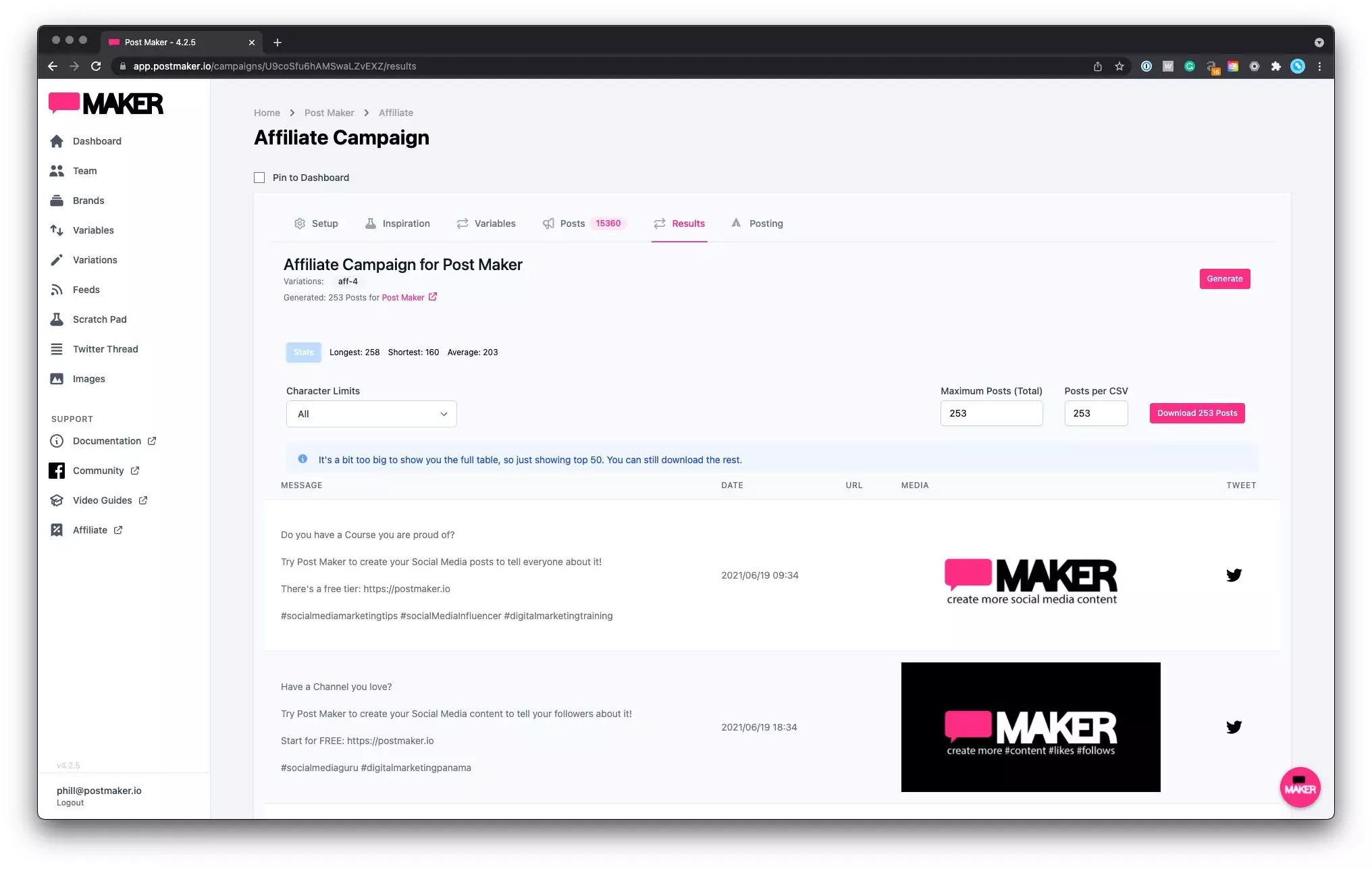A blog about...
Social Media Experiments: Part One
In this post, we’re going to explore some ways to experiment with your Social Media Posts. We will discuss the different levers, pulleys, switches and dials we can yank, twist, cajole and caress to get our content doing as well as we can.
As ever, we want to maximise the effort we put into creating content to get the best results for our business, our brand or our message.
Social Media networks don’t exist to promote your organic posts. They live to keep users engaged, learn their demographics and behaviour so that the Social Media Platforms can sell advertising real estate to the highest bidders. So if you create a post that is getting engagement, the algorithms will fire into action to help show it to more users who may also find it attention-worthy alongside some scarily accurate social media ads.
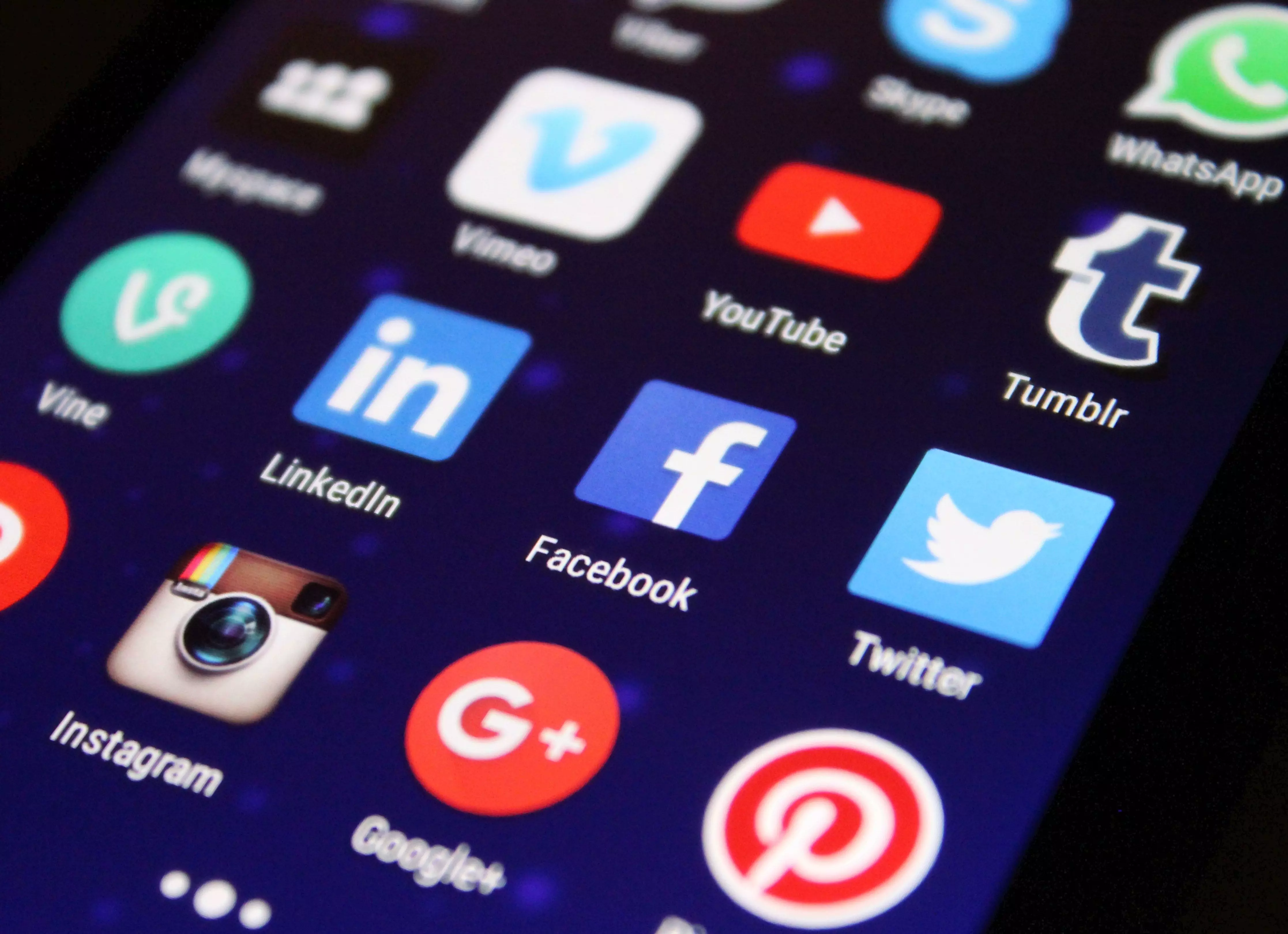
By looking at the options below to play with, we will use PostMaker to try many combinations. Then, finally, we will track, measure and come back with Part Two.
Remember to optimize for humans, not for algorithms. If you are using automated systems like Schedules then you’ll be able to do much of what I’m about to describe without having to think too hard. However, you’ll need to know how to test manually first which means knowing where to look in each platform’s analytics, plus understanding when an algorithm might have changed something.
Do we know what works?
It depends; some brands will get engagement for almost anything they post, they have a large loyal following who will respond to anything they see. Others can post prized content but don’t reach to break into the trending side of things. Finally, you have luck or self-made luck, sometimes the right timing, the right retweet from the Right Person with the right-mention might start a chain reaction into the limelight. Given the amount of content produced every few seconds, the odds are incredibly minute.
The other thing about social media experiments is that there is no guarantee that anything you do will work out well. If you try one experiment, then another, and another, you’ll never really find out which ones worked best. So why bother trying at all? Because we don’t always know what works until we test it!
The ‘So What’ Test
Anything we post to Social Media needs to pass the So What Test, it is a friend of the What’s In It For Me (WIIFM) Test.
When you are asking someone to take the time to read, engage, share your content is there something in it for them? Does someone prefer to look at your new eBook because it exists, or because it can double their income in six weeks?
What makes you engage with content?
Sometimes people overlook the type of things that are ‘scroll-stoppers’ for themselves. There will be times when you are swiping down your news feed, and then you stop. Something has caught your attention, and now you are giving valuable time to the words written on your timeline - you should stop to think about what it is - did it just fit your mood, something out of the ordinary, from someone you knew? Try and think next time you find yourself pausing that scroll.
How to experiment?
- Ask a question.
- Perform research.
- Establish your hypothesis.
- Test your hypothesis by conducting an experiment.
- Make an observation.
- Analyze the results and draw a conclusion.
- Present the findings
The question we are asking is ‘What changes to a Post has the most positive outcome on engagement?’ We are going to look at all the things we can work with, use PostMaker to build up some posts, schedule them and then measure what the impact is.
That’s all we need to do. In the following section, we are going to explore the different things that we can try.
You might think there are only a few different bits that you can test out.
There’s a lot.
We are going to experiment with PostMaker.
There are lots of great posts out there, but we’re going to use the power of generating posts with PostMaker to create, track and find the results out ourselves.
We will do some Social Media Marketing for ourselves and share the conversion rates, click-through rates and anything else we can get across different Social Platforms.
We will be mixing in some promotional, some engagement and some random posts.
Experimenting with Words
Original, Canned or AI
Creating Social Media content takes time and effort. It is usually only part of a broader Digital Marketing Strategy, so sometimes people want to expedite the process, but is it worth it?
The most important thing to remember when creating content is to write for yourself first. If you’re not enjoying what you’re writing then it’s unlikely anyone else will either.
Canned or premade content
I am not a fan of the ‘Social Media Packs’. You can download quotes or ready-made noise. They’re very skippable, and because they are so easy to download, schedule and post, the news feeds are full of them.
You’ve got to ask, “Will the Social Media Companies think they are worth showing?” - if they’ve seen the same content posted by goodness knows how many accounts, will they believe it valuable to highlight in everyone’s feeds? Do you engage with them?
AI
AI is something that is gaining a lot of traction. You can enter a topic, and wham-bam, a host of posts are created for you by the AI. Dubious in factual correctness, sometimes it can be a great way to get you started, even if it’s just to come up with some ideas. However, because an AI is creating them, they may not ‘sound’ like you or your brand - the great post content it comes up with could jar against the normal flow of content you produce. Are people using them because they are not confident in their writing abilities because they want to scale their efforts or something else?

Machines writing content. Maybe not these actual ones though.
Original content
Original Content is between the author, the keyboard and the post button. Starting from scratch takes the most time, but you are in control, and hopefully, you know the desires, needs and wants of your followers. Taking the time to tailor, react to any responses will come the most natural. Comparing this to a canned or AI post, it might just feel like you’re responding on someone else’s feed.
Length
Choosing the length of your post is interesting and one where you need to think about whether you’re writing for the benefit of your readers or trying to match a magical number you saw for the ‘Ideal Facebook Post Length.’ I’m not saying it’s not important to think about these things - know your audience, know the platform you’re posting to, know your goal are key.

A count of 75k Twitter posts showed an average length of 127 characters, that’s pushing 45% of the limit for Twitter - but do more words mean more likes?
Maximum
Ideal
63k
40-80
2.2k
150
280
70-100
1300
50-100
Social Media Post Guides - they’re just guides
We are going to try with a broad range of post lengths to see how we get on.
Formatting
The structure of your writing is something that we have control over. Do we want to format nicely into new paragraphs or squish it all together?

Post with no spacing
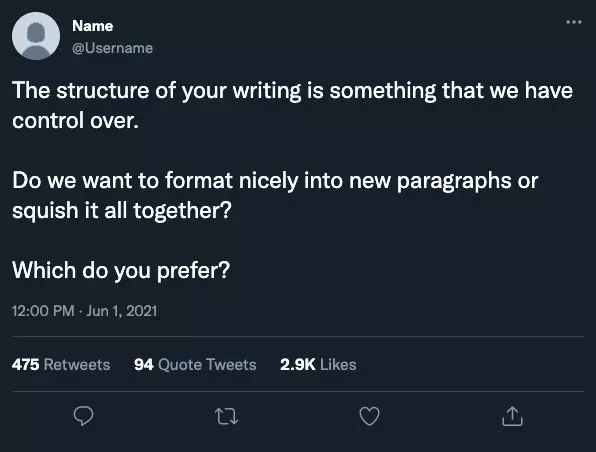
Spacing out the paragraphs
Does making it aesthetically pleasing mean anything? Does taking up more vertical real estate make it stand out more?
Reading Age
The minimum age for someone to use Twitter is 13, but it doesn’t mean the reading age will be higher.
The average American is considered to have a level that is comparable to a 7th or 8th grader, so that’s just about where Twitter’s doors open, 12 to 14 years old reading age.
How you target the language you use will be up to your audience and who you want to appeal to. There will be times where you can be as striking and outrageous with your language and other times where you want it as simple as possible.

Say what?!
Always remember that your readers might not necessarily share the same first language as yourself. If you have a global following, you should consider if more obscure idioms or colloquial language will move your post into the unreadable sin bin.
Grammar
Following the grammatical guidance of something like Grammarly is a stylistic choice. You will get some people who will cringe if there are glaring omissions or text-speak within the content. Sometimes this can be down to a brand style guide; other times, there may be more freedom to experiment.
Using the built-in spell checkers that come with most browsers will see you through. In addition, there are more advanced tools such as Grammarly and Hemingway, which can support your writing.
As in the Reading Age section, if you have got non-native readers, will they struggle if you are not following common grammatical patterns?
Tense
When composing a tweet, you might well be referring to something which is happening, has happened or will happen in the future - this could be a blog post, an event or something else.
People like ‘fresh’ news.
Does ‘Check out my blog post’ vs ‘Check out my new blog post’ make a difference? How about ‘Check out my old blog post’?
Are we in a world where new is better, something happening right now is more appealing? Do people prefer a ‘first look’ at something or a ‘previous top performing’ post which has stood the test of time?
Point of View
Who is the Person writing a post, and who is it for. There’s a different feel depending on
- First Person: “I wrote a blog post about Dogs.”
- Second Person: “You will learn so much about Dogs.”
- Third Person: “Dog fans will love this post.”

Cute dog, can you relate?
Does anyone care that you wrote it? In the gentlest possible way, we need to ask this question.
You might be well known, top in your field, the industry expert, and that will be something people expect you to produce. But, on the other hand, you could also be a relative nobody, and you can’t offer the post any gravitas simply because it came via your keyboard.
Appealing to the reader via second or third Person can give the “oh, that’s me - I love dogs” and give you a hook.
Intro
People scan their News Feeds, well, there’s a lot to get through, and they will naturally check the first words. What are you saying?
”Fun Fact: …"
"I made …"
"Holy smoke …”
They say you get one chance with a first impression. The same is with your post. So what makes people think it is worth reading on?
Emoji
Our keyboard, for better or worse, can now produce emojis. Emojis can say so much in so little.
The nice thing is their charming appearance can stand out in a long feed of text. The cute faces and colours add a splash of excitement and help break up the monotony.
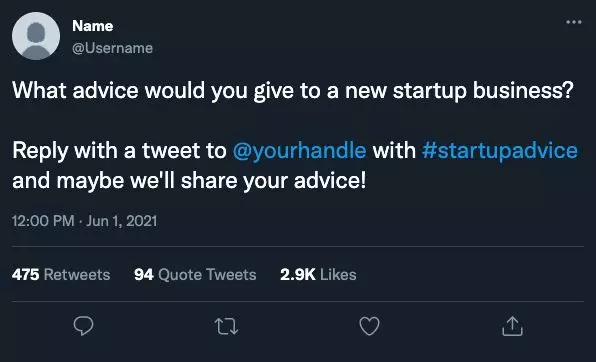
No emoji

A fair few emojis
It would be best to be careful that your combinations and positioning couldn’t be misinterpreted or misconstrued.
If you can say it with words, do you need the emoji? Do you use just an emoji?
Sentiment
Social Media Sentiment Analysis is a pretty hot topic, brands mainly use it to see if people are saying nice or not so nice things about them, but that’s not quite what we’re looking at here.
You also use sentiment in your toolbox to evoke different reactions and engagement. If you’ve reviewed a product, does mentioning its flaws get more clicks than the good bits?


There is tremendous power in every word you place into that tiny Social Media box. Online users are more sensitive to negative content compared to positive content.
Bulllying and harassing is never OK on Social Media, don’t do it.
Content-Types
Whether you’re writing to fill all of Facebooks characters or a brief Twitter post, there will be different types of posts that you will be putting out into the news feed of your audience.
Questions
Asking a question is an excellent way to get some engagement, if
We posted about this on our other blog post - Socia Media Interaction Guide (Open vs Closed Questions)
General Facts and Quotes
Mostly these are grabbed from somewhere on the internet, some ‘swipe file’ and are scheduled to fill in the blanks. I don’t like them they really are just noise.
Just head over to https://twitter.com/hashtag/quote and you will see the ones that I mean.
It feels (I need to check) most accounts posting this type of content is trying to build a ‘fake’ audience. They offer no real value as the audience is not truly engaged.
We will test to see if people like these or ignore them. As mentioned in the section above about canned content, it might not make much sense for the algorithms to favour this type of content.
Statements and Opinion

”Cheese is the worst food” - if you posted this, I am sure you’d get a fair few responses from both sides of the argument. However, if it’s relevant to your product, brand or service, it might be worth testing out some bold or not so bold statements.
Do you want to post controversial things and most likely go against the grain of popular opinion or the consensus of your audience, or do you want to reaffirm their views and alignment to your brand?
Passive and Active Voice
Grammarly has an excellent article on Passive Voice that explains Passive and Active writing in detail - watch out for the Zombies, though.
A post can change when you play with the voice.
Passive: “Our exciting new range has been launched”
Active: “We have launched our exciting new range”
Visual
Time for a bit of graphic content. Does it make a difference? Well, it seems like it.
Are our choices just limited to picture or no pictures? Not really there’s a whole host of options to play around with.
Images on Facebook receive 20% more engagement than videos and 352% more engagement than links.
Don’t be exclusive - your content should be consumable by everyone. If your complete message is only accessible by those with sight and hearing, you’re missing out, and so are your followers.
Picture
Picture or no picture, it’s a good question. If there’s a picture that fits, then the statistics seem to show that it is beneficial to get people to look at what you’re writing.
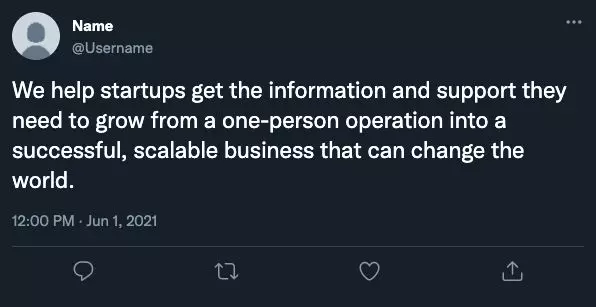
Post with no image
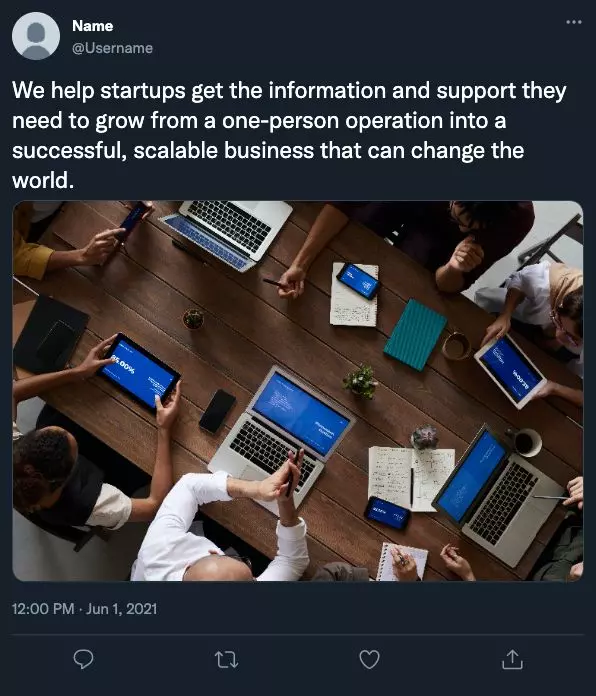
An image helps tell a story
A picture allows you to give more information to a user and takes up more real estate on the page
Did you know? Images or media attached to Tweets will have precedence over any card attached to a URL.
Captions
Add some ALT text for those that need additional help. Make it meaning complete, correct and provide the same amount of information as the image represents.

I would suggest not experimenting with this, just add it whenever you can.
Related to content
Are you adding an image to grab attention? Will a viewer feel short-changed by your bait-and-switch technique? Or are you drawing their eye, and they will be delighted?
Stock Images
Oh no, Stock Images are so overused they’re almost a parody of themselves. To be honest, I have used them liberally throughout this post - I feel no shame.
It could be that the same image of a multicultural team leaning over a laptop is what conveys your message more than anything else in the world. But, unfortunately, it can also show laziness, lack of attention to detail and corporate boringness, which is an immediate turn-off.
There are some great pictures out there. The world of Unsplash or Pexels has given content creators a massive pool of high quality snaps to use - but its success may be the downfall as you recognise the same thing from other channels content.
Funny
Is something funny going to stop someone in their tracks? a snigger to get them smiling before they read on in a good mood?
Abstract
Is some fancy abstract artwork a way to show your creativity, something unique in the feed? Does it have any purpose apart from to stand out and catch someones attention?
Human
People like people’s faces, it seems weird when I write it like that, but it is true.
New study shows that Instagram pictures with human faces are 38 percent more likely to receive likes than photos with no faces. They’re also 32 percent more likely to attract comments.
https://www.news.gatech.edu/news/2014/03/20/face-it-instagram-pictures-faces-are-more-popular
A smiling human face looking at us makes us smile. It draws us in.
It can show a human side to your business too.
Real
A face can be powerful. Experiment with photos to see the difference. Is it a face profile, a cutout on a background or a full body shot? Do facial expressions alter the click-through rate? Try them out.
I have a real gripe against people using Stock Images of people and passing them off as their employees or clients, don’t do that. In Chrome, if you right-click on an image you’re unsure of you can select ‘Search Google for this Image’
There are some crazily good tools like - https://thispersondoesnotexist.com/ - but seeing as though that person ‘does not exist’ you can’t or shouldn’t claim they are.
Cartoon
Does a character or cartoon version of a human have the same effect? Do people get suspicious of why it’s not a real person or do they think it’s cute? Do they know what you look like and see the cartoon as a way to express yourself without getting the camera out?
Colours
There’s a whole palette of colours that convey a million different messages, from happy to sad, exciting to sedate.
There’s a world of colour theory with some rules to help you choose a colour correctly. But, unfortunately, two poorly chosen colours can baffle and confuse.
Colour Contrast is essential. It helps your message stand out. Top tip, try turning your picture to grayscale and see if it still tells the story you need.
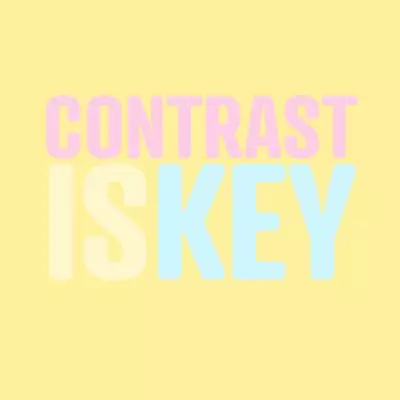
Not so good Contrast

Better Contrast
Accessibility, if you’re choosing to present a lot of your messaging in the image rather than in text format, have you considered colour blindness?
Worldwide, about 300 million people have colorblindness. About 2.2 billion people have vision issues
https://www.uxpin.com/studio/blog/evaluate-design-color-contrast/
Movement
Something which moves catches our eye. It’s the way our brain is wired. When it comes to Social Media, there are two main options for adding some motion.
Gifs
The mini silent movies are everywhere, and the GIF button has been embedded into most platforms and modern smartphone keyboards to make them only a click away. Meme’tastic, there’s an animated gif easily insertable. So you can convey a message pretty quickly using them. They can also provide familiarity to your scroller if they recognise a TV character, a singer or an animal they love.

Gif Like Giveaway
Does using a GIF provide a quick dopamine kick but leave the message unread? Does it encourage further exploration or just a moment of interest?
MP4
Videos give you a way to add some sound to accompany your visuals. Where are your readers looking at the post, is it somewhere a sudden audio track isn’t appropriate? Do people want to hear the sound? I am sure they’d appreciate some subtitles.
Mentions
With Twitter, you can @mention to get someones attention. But don’t abuse it, Twitter doesn’t like it, and I can imagine if @Beyonce gets tagged for the millionth time this hour, she’ll get a bit grumpy.
Posting automated mentions and replies
The reply and mention functions are intended to make communication between Twitter users easier. Automating these actions to reach many users on an unsolicited basis is an abuse of the feature, and is not permitted. For example, sending automated replies to Tweets based on keyword searches alone is not permitted. Spammy or duplicative use of mentions and replies may result in enforcement action, such as the removal of your Tweets from Search or the suspension of your app or account.
https://help.twitter.com/en/rules-and-policies/twitter-automation
Does mentioning someone help? Are you better off talking to them outside of your post? Is it better if they were to find and interact with your post organically?
Does the mentioned Person care? Could it be wrong if the first comment you get is, “Why did you tag me?”
Hashtags
A million articles exist on the perfect amount of hashtags to include depending on the Social Media Channel. Too many, and you look spammy, too few, and you could be missing out.
Is quantity the right thing to be looking at? Is it better to be specific in your hashtags or see if you can fit into a popular but more general one?
Time of Day
When should you post? Does it matter? If someone like a post at 2 pm last Friday, are they more or less likely to look at something at 2 pm this Friday?
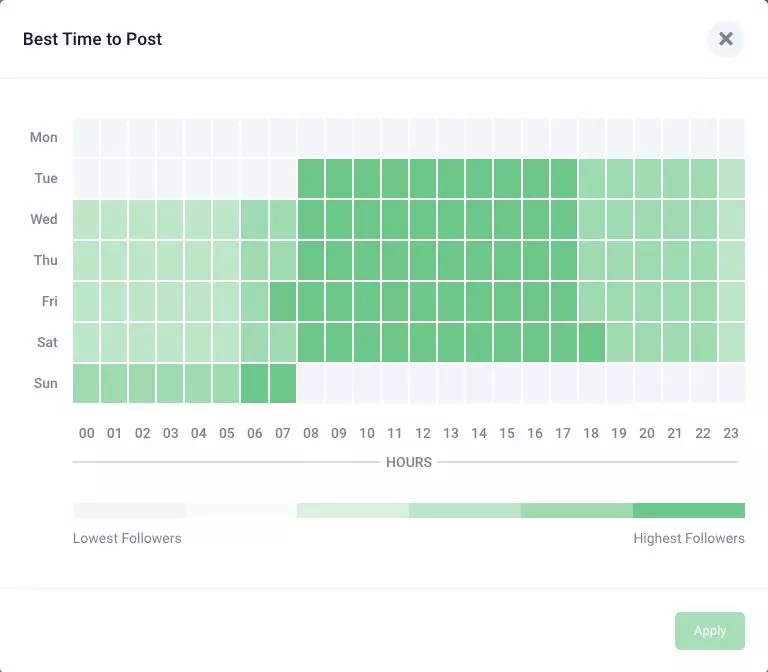
Tools like RADAAR can help you choose the best time to post
There will be general times when people are on their phones or at their desks looking at posts. Do you want to join in the fray and post when everyone else is? Do you want to get in there before the avalanche or wait for things to calm down?
Call to Action
Do people do what we tell them? For example, if you finish off a post with “click this link”, are they going to be more driven to do so than under their guidance?
Should a call to action describe a benefit or positive outcome?
”Find out more” vs “You’ll be a hero when you learn how.”
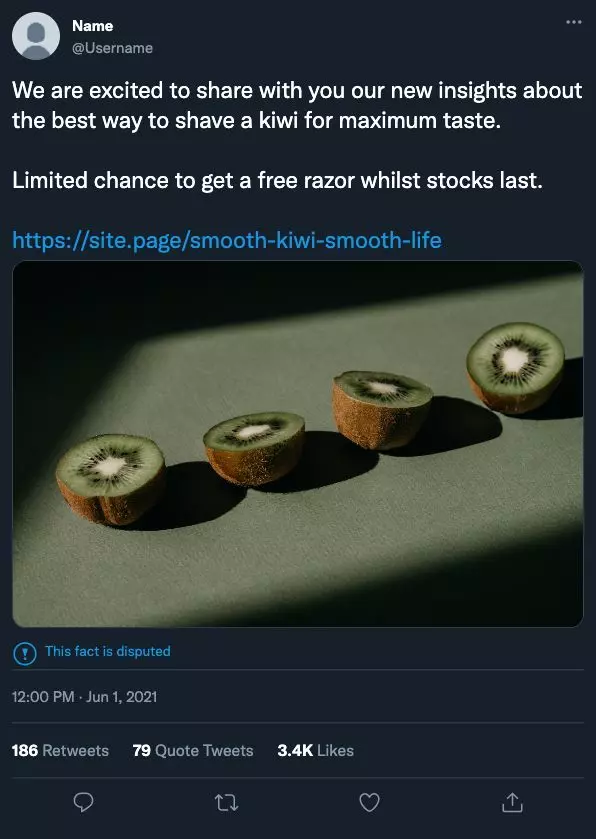
Does making it more urgent make a difference?
Link
”You’re leaving us?” is what a Social Media Network thinks every time a user clicks a link that takes them away from their platform. All those Ad dollars spent on advertising to the clicker are no longer in reach as they set sail into the interwebs. They’ve put a pixel on to keep tabs and keep reminding them they do want that new-fangled dish-spin-washer-tastic thing.
It is worth thinking about though, are you creating content purely to leverage someone off their social-media-high to get eyes onto your website? Can you be delivering value to your audience where they were? Does it build trust by demonstrating the value in-situ?
If you provide a link, is it a straight link to your page? Are you masking it behind a URL Shortner to analyse the results, set a cookie and retarget the user? Does a masked link reduce confidence? Does using bit.ly or owly give more or less trust than a branded short URL
Which do you trust?
Open Graph and Twitter
It would be best to use Open Graph and Twitter Cards on your website to give you some control over how your content is displayed when shared on Social Media. There’s a fair few tools that can help you set this up in no time.
Time to build some posts
My next task is to build some posts using PostMaker to test all these options.
Ready to dive in?
Try it at no cost.
Make your day significantly better and check out PostMaker today.
